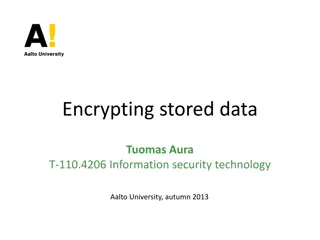Understanding Secure Messaging and Encryption Techniques
Explore the possibilities of sending secure messages through encryption without the need for advanced degrees in Computer Science or Math. Learn about symmetric and asymmetric key encryption methods, the use of PGP for secure messaging, and the concept of shared-key encryption. Discover the intricacies of advanced encryption techniques like Triple DES and the characteristics of secure communication through encryption methods.
Download Presentation

Please find below an Image/Link to download the presentation.
The content on the website is provided AS IS for your information and personal use only. It may not be sold, licensed, or shared on other websites without obtaining consent from the author. Download presentation by click this link. If you encounter any issues during the download, it is possible that the publisher has removed the file from their server.
E N D
Presentation Transcript
Secure Messaging Paul Hrycewicz Computer Science October 20, 2022
Is any of this actually possible? Can you use your computer (or phone) to send a message to somebody that nobody else can read? Answer: Yes. Do you need an advanced degree in Computer Science or Math to do this? Answer: No. Is the software needed freely available, and easily installed and used? Answer: Yes. Is there any way for law enforcement or government to prevent this from happening? Answer: Practically speaking, no.
Agenda How do we send and receive secret messages? Encryption algorithms Secure messaging asymmetric key encryption PGP (Pretty Good Privacy) Kleopatra Demo Is secure messaging really secure? Is it a good thing or a bad thing?
But FirstEncryption For Kids We did this as kids we sent secret messages using a simple substitution cipher Let s send HELLO H E L L O -> P -> I -> F -> M -> M message sent is IFMMP How did we encrypt? How does the receiver decrypt?
Shared-Key (Symmetric) Encryption The example we just did shows shared-key encryption For shared-key encryption, both the sender and receiver must have the algorithm and the key key triple DES algorithm plaintext ciphertext It s symmetric because the same algorithm and key are used by the sender and receiver
Advanced Encryption One example Triple DES Given: the algorithm (Triple DES) and an encryption key (3 x 64 bits) Shuffle the bits in the plaintext Derive 16 different keys from the given key using a combination of shifting and shuffling Split the plaintext into two halves Encrypt and re-encrypt each half 16 times using the 16 keys Combine the two halves into text Repeat the above process three times using the three given encryption keys Plaintext + key = ciphertext: hello + 2jd8932k = X5xJCSyc Ciphertext + key = plaintext: X5xJCSyc = + 2jd8932k = hello
Characteristics of Shared-Key Encryption It s secure as long as: the encryption algorithm is sufficiently complex the shared key is known only to the sender and receiver What do we mean by secure? It means that a third-party eavesdropping on the transmission line will not be able to decipher (decrypt) the message Big problem: How does the sender get the key to the receiver? (key exchange) Cannot send in plaintext, as that could be intercepted Cannot encrypt and send, as the receiver would not know how to decrypt No such thing as a secure transmission line Possible to hide a key within an object, such as a picture, but this can be detected
Asymmetric Key Encryption Solves the key-exchange problem Developed by Whitfield Diffie and Martin Hellman, with help from Ralph Merkle (all then at Stanford), commonly referred to as Diffie-Hellman Key Exchange, published in 1976 (see New Directions in Cryptography, IEEE Trans. Information Theory, 1976) The method centers on two keys: a public key and a private key
Public Keys and Private Keys To receive an encrypted message, the receiver creates a public key and a private key Very easy to do, but underlying mathematics are complex see: ssh-keygen The receiver tells the world what their public key is, but keeps the private key secret The keys are mathematically linked using large prime numbers. The encrypted text is also mathematically linked with the keys. Given keys of sufficient complexity, it is practically impossible to derive the private key from its public key
Sending a Secure Message Let s assume Frank wants to send Betty an encrypted message. Betty creates a public key/private key, and broadcasts the public key, but keeps the private key secret Frank encrypts the message using Betty s public key, and Betty decrypts it using the private key Frank Betty message encrypted message encrypted message encryption decrypted message decryption Betty s public key Betty s private key As long as Betty s private key stays private, the message is secure The messaging is secure since the private key is never exposed, like the key with symmetric encryption
PGP (Pretty Good Privacy) Phil Zimmerman developed PGP and released it in 1991 as the first package to use asymmetric key encryption The US government began a criminal investigation of Zimmerman for munitions export without a license. Zimmerman responded by publishing the source code for PGP. The government eventually abandoned its investigation Zimmerman s work eventually became the OpenPGP standard Today PGP is the most widely-used encryption process It s easy to download, install, and use. See a version called Kleopatra Another popular use of asymmetric key encryption, in conjunction with cryptographic hashing, provides digital signatures A digital signature is a method of preventing an impostor from sending you a message
Public / Private Key Generation It s easy for a user to generate keys use ssh-keygen command on Windows, Mac, Linux Generates keys approximately 14,000 bits long Using ssh-keygen is easy. PGP is easy. Kleopatra is easy. The real challenge is generating keys that cannot be discovered Many such key generation algorithms exist The easiest method to understand is based on the multiplication of large prime numbers The public key is chosen using the product of the primes The private key is derived using the public key and the original two primes It is very easy and fast to multiply the original two primes, that s just straightforward multiplication But it s time-impossible to determine the factors of the public key, which are needed to derive the private key
Kleopatra Demo Send a secure message from frank@laspositascollege.edu to betty@laspositascollege.edu Download kleopatra from www.openpgp.org Software is open-source and signed, so you can be sure you download, install, and run the real software and not some impostor The software can be embedded into any applications you wish, including email and text messaging
Is Secure Messaging Really Secure? The short answer is yes, at least for now, if you do it correctly You need to generate sufficiently random keys of sufficient length to prevent patterns from occurring and to guard against brute-force attacks Potential weaknesses: poor random-number generation cursor movement patterning man-in-the-middle attack human factors quantum computer attacks Estimates of the length of time required for a brute-force attack range from 70 years to millions of years, depending on the key length Key generation and other security-related algorithms are being developed that are impenetrable by quantum computers
Is Secure Messaging Good or Bad? On the plus side, HTTPS is based on asymmetric key encryption On the negative side, secure messaging can be used for criminal or terrorist activity No matter what your point of view, or that of any government, there is no way to prevent secure messaging Prevention is also beyond the reach of device manufacturers. They can provide encryption software, or allow it to run on their devices, but since they do not control the keys or algorithms, they cannot decrypt messages or provide information to governments A backdoor into an encryption system can be built-in, but the system then becomes immediately untrusted. Why would anybody use an untrusted system? OpenPGP is one example of open-source software, which can be inspected and validated by anybody before it is used























